| |||||
| Decades: | |||||
|---|---|---|---|---|---|
| See also: | Other events in 1843 · Timeline of Icelandic history | ||||
Events in the year 1843 in Iceland .
| |||||
| Decades: | |||||
|---|---|---|---|---|---|
| See also: | Other events in 1843 · Timeline of Icelandic history | ||||
Events in the year 1843 in Iceland .
Faroese is a North Germanic language spoken as a first language by about 69,000 Faroe Islanders, of which 21,000 reside mainly in Denmark and elsewhere.

Scandinavia is a subregion of Northern Europe, with strong historical, cultural, and linguistic ties between its constituent peoples. Scandinavia most commonly refers to Denmark, Norway, and Sweden. It can sometimes also refer to the Scandinavian Peninsula. In English usage, Scandinavia is sometimes used as a synonym for Nordic countries. Iceland and the Faroe Islands are sometimes included in Scandinavia for their ethnolinguistic relations with Sweden, Norway and Denmark. While Finland differs from other Nordic countries in this respect, some authors call it Scandinavian due to its economic and cultural similarities.

The Nordic Council is the official body for formal inter-parliamentary Nordic cooperation among the Nordic countries. Formed in 1952, it has 87 representatives from Denmark, Finland, Iceland, Norway, and Sweden as well as from the autonomous areas of the Faroe Islands, Greenland, and Åland. The representatives are members of parliament in their respective countries or areas and are elected by those parliaments. The Council holds ordinary sessions each year in October/November and usually one extra session per year with a specific theme. The council's official languages are Danish, Finnish, Icelandic, Norwegian, and Swedish, though it uses only the mutually intelligible Scandinavian languages—Danish, Norwegian, and Swedish—as its working languages. These three comprise the first language of around 80% of the region's population and are learned as a second or foreign language by the remaining 20%.

Christian X was King of Denmark from 1912 until his death in 1947. He was also the only King of Iceland as Kristján X, holding the title as a result of the personal union between Denmark and independent Iceland between 1918 and 1944.
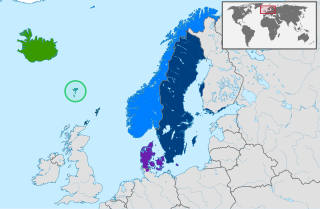
The North Germanic languages make up one of the three branches of the Germanic languages—a sub-family of the Indo-European languages—along with the West Germanic languages and the extinct East Germanic languages. The language group is also referred to as the Nordic languages, a direct translation of the most common term used among Danish, Faroese, Icelandic, Norwegian, and Swedish scholars and people.

The northern region of Europe has several definitions. A restrictive definition may describe northern Europe as being roughly north of the southern coast of the Baltic Sea, which is about 54°N, or may be based on other geographical factors such as climate and ecology.

Rasmus Kristian Rask was a Danish linguist and philologist. He wrote several grammars and worked on comparative phonology and morphology. Rask traveled extensively to study languages, first to Iceland, where he wrote the first grammar of Icelandic, and later to Russia, Persia, India, and Ceylon. Shortly before his death, he was hired as professor of Eastern languages at the University of Copenhagen. Rask is especially known for his contributions to comparative linguistics, including an early formulation of what would later be known as Grimm's Law. He was elected as a member to the American Philosophical Society in 1829.
The Nordic Council Literature Prize is awarded for a work of literature written in one of the languages of the Nordic countries, that meets "high literary and artistic standards". Established in 1962, the prize is awarded every year, and is worth 350,000 Danish kroner (2008). Eligible works are typically novels, plays, collections of poetry, short stories or essays, or other works that were published for the first time during the last four years, or in the case of works written in Danish, Norwegian, or Swedish, within the last two years. The prize is one of the most prestigious awards that Nordic authors can win.
The Arnamagnæan Institute is a teaching and research institute established in 1956 to further the study of the manuscripts in the Arnamagnæan Manuscript Collection, the collection bequeathed by the Icelandic scholar and antiquarian Árni Magnússon to the University of Copenhagen in 1730.
Icelandic Sign Language is the sign language of the deaf community in Iceland. It is based on Danish Sign Language; until 1910, deaf Icelandic people were sent to school in Denmark, but the languages have diverged since then. It is officially recognized by the state and regulated by a national committee.
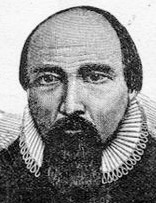
The Passíusálmar or Passion Hymns are a collection of 50 poetic texts written by the Icelandic minister and poet, Hallgrímur Pétursson. The texts explore the Passion narrative, as traditionally presented, from the point where Christ enters the Garden of Gethsemane to his death and burial. Hallgrímur began composing the work in 1656, while serving as pastor of Saurbær in Hvalfjörður. It took him three years to complete, the final poem being written in May 1659; the first edition was published seven years later, in 1666. By the end of the century they had become so popular in Iceland that five editions had been published. Since that time, they have been reprinted more than 75 times, a unique achievement in Icelandic literature. The poems were translated into many other languages, including Latin, English, Chinese and Danish.

Faroese literature, in the traditional sense of the word, has only really developed in the past two hundred years. This is mainly because of the islands' isolation, and also because the Faroese language was not written down in a standardised format until 1890. Until then the Danish language was encouraged at the expense of Faroese. Nevertheless, the Faroese language soon became a vehicle for literature in its own right and has produced writers in several genres.
Linguistic purism in Icelandic is the policy of discouraging new loanwords from entering the Icelandic language by instead creating new words from Old Icelandic and Old Norse roots. In Iceland, linguistic purism is archaising, trying to resuscitate the language of a golden age of Icelandic literature. The effort began in the early 19th century, at the dawn of the Icelandic national movement, aiming at replacing older loanwords, especially from Danish, and it continues today, targeting English words. It is widely upheld in Iceland and it is the dominant language ideology. It is fully supported by the Icelandic government through the Árni Magnússon Institute for Icelandic Studies, the Icelandic Language Council, the Icelandic Language Fund and an Icelandic Language Day.
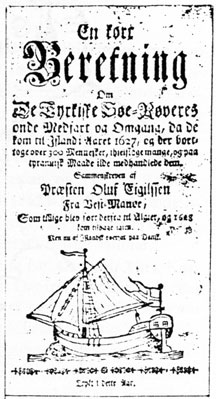
Ólafur Egilsson was an Icelandic Lutheran minister. In 1627, he was abducted, along with his wife and two sons, by Barbary Pirates under the Ottoman Empire during their raid on Vestmannaeyjar. The raid is known in Icelandic history as Tyrkjaránið. He returned to Vestmannaeyjar in 1628 but his wife Ásta Þorsteinsdóttir did not return until 1637 and his sons never returned. He later wrote a memoir of his abduction and return, which was published both in Iceland and in Denmark.

Iceland has been a very isolated and linguistically homogeneous island historically, but has nevertheless been home to several languages. Gaelic was the native language to many of the early Icelanders. Although the Icelandic or Norse language prevails, northern trade routes brought German, English, Dutch, French and Basque to Iceland. Some merchants and clergymen settled in Iceland throughout the centuries, leaving their mark on culture, but linguistically mainly trade, nautical, and religious terms. Excluding these and Latin words, Icelandic has been altered remarkably little since settlement.

The Faroe or Faeroe Islands, or simply the Faroes, are an archipelago in the North Atlantic Ocean and an autonomous territory of the Kingdom of Denmark. The official language of the country is Faroese, which is closely related to and partially mutually intelligible with Icelandic.
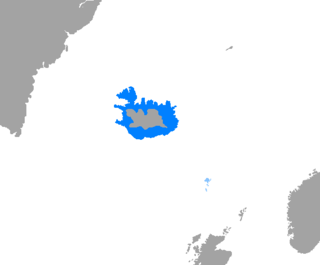
Icelandic is a North Germanic language from the Indo-European language family spoken by about 314,000 people, the vast majority of whom live in Iceland, where it is the national language. Since it is a West Scandinavian language, it is most closely related to Faroese, western Norwegian dialects, and the extinct language Norn. It is not mutually intelligible with the continental Scandinavian languages and is more distinct from the most widely spoken Germanic languages, English and German. The written forms of Icelandic and Faroese are very similar, but their spoken forms are not mutually intelligible.
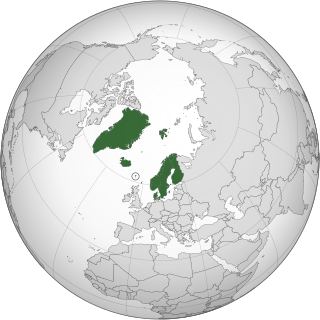
The Nordic countries are a geographical and cultural region in Northern Europe and the North Atlantic. It includes the sovereign states of Denmark, Finland, Iceland, Norway and Sweden; the autonomous territories of the Faroe Islands and Greenland; and the autonomous region of Åland.
Events from the year 1786 in Denmark.
Events in the year 1907 in Iceland.